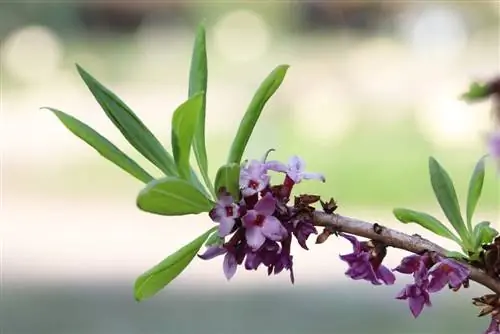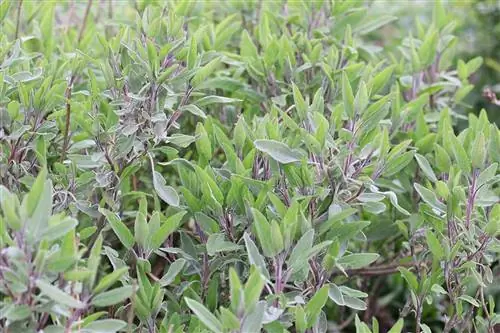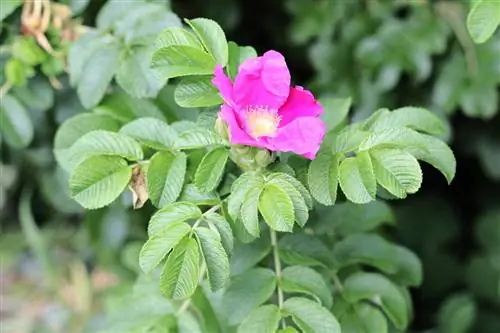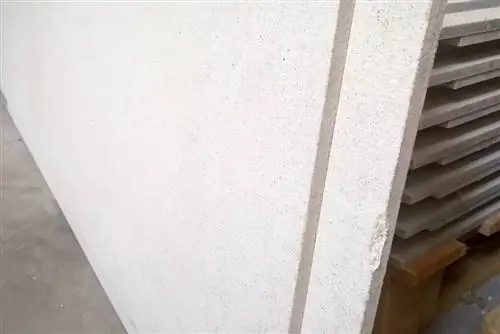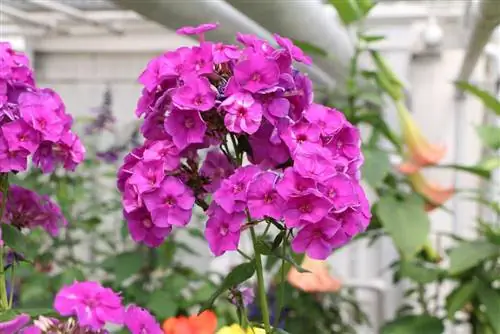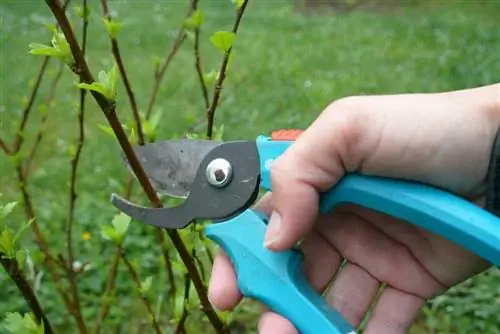- Author admin [email protected].
- Public 2023-12-17 03:39.
- Last modified 2025-01-24 12:45.
A lovely herald of spring comes under the name daphne. When the decorative ornamental tree unfolds its blossoms in spring, it creates a picturesque appearance full of anticipation for the most beautiful time of the year. Once the flower clouds have cleared, the charming shrub is far from having used up its powder. This is followed by a rich green foliage and a bright red berry cluster. The following lines show in detail how you can care for the pretty daphne and how cutting and propagation work.
Profile
- Plant family Daphne family (Thymelaeaceae)
- Genus Daphne (Daphne)
- More than 90 known species
- Mostly deciduous shrubs
- Growth heights from 30 to 150 centimeters
- Early flowering from February/March in many colors
- Elongated leaves from rich green to light green
- Mostly red, rarely yellow berries in autumn
- Highly toxic in all parts
The wild forms of daphne are threatened with extinction in the wild and are therefore subject to nature conservation law.
Location
The choice of an adequate location is the top priority for the successful cultivation of daphne. Although the ornamental tree is represented in divergent habitats around the globe, its requirements for the optimal location focus on the following conditions:
- Sunny to semi-shady location
- Lovely warm and airy
- Wind-exposed locations are accepted
In view of the wide range of species and varieties, you can specifically select the daphne that perfectly suits the light and temperature conditions on site. Breeds are available that thrive in the twilight of high forests. Other wild forms climb in windswept mountains up to 3,000 meters altitude. With the most common type, daphne, you are always well advised in the local regions.
Soil texture
The condition of the soil is of utmost relevance for successful care. The vast majority of all daphne species can be found in locations with permeable raw soils that are poor in nutrients and have a thin layer of humus. These basic requirements make the ornamental tree ideal for cultivation in stone and gravel gardens. The central requirements in detail:
- Sandy-dry to loamy-gravelly soil
- No risk of waterlogging
- Low proportion of organic materials
- Preferably calcareous
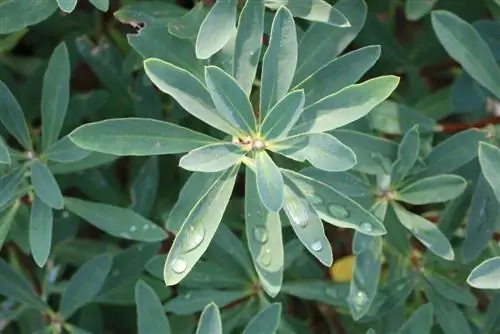
It can be concluded that a classic garden soil with lots of nutrients and a comparatively heavy structure needs to be improved. Soil additives such as fine-grained sand and sifted compost work small miracles in this regard. This means that when choosing a location, you are not limited to the typical rock garden, but can easily plant a Daphne in other regions of the garden.
Tip:
In the pot, daphne thrives excellently in high-quality pot plant soil, enriched with sand, vermiculite or lava granules.
Care
One of Daphne's outstanding attributes is her remarkably deep roots. In its natural distribution areas, the ornamental tree is forced to obtain the substances it needs from deep in the ground due to a lack of nutrients and water. This results in the following aspects of care:
- Watering only required during prolonged dry periods
- Do not fertilize daphne in the bed
- Fertilize potted plants from February to July/August
- Preferably administer phosphorus-concentrated liquid fertilizer in half concentration
Overwintering cannot be treated in general terms because not all daphne species are hardy. The degree of their winter hardiness is closely linked to the specific species and location. Cold per se has little effect on most trees. It is the temperature fluctuations that cause problems. To be on the safe side, winter protection is advisable. In the bed, a layer of leaves, straw or pine fronds takes on this task. For potted plants, an additional container cover made of bubble wrap or garden fleece is important. There is a great risk here that the almost unprotected root ball will otherwise freeze. Regardless of the extent of winter protection, you must not neglect to water the plants when there is clear frost. If there is no moisturizing snow cover while it freezes, there is a risk of drought stress. Mediterranean Daphne species are an exception. These should be relocated to frost-free winter quarters in the fall because they cannot tolerate sub-zero temperatures.
Cutting
With regular pruning, experienced hobby gardeners can maintain the vitality and abundance of flowers in their daphne for many years. As a classic spring shrub, the best time for shape and maintenance pruning is immediately after flowering. Since the plant always flowers and produces fruit on the previous year's wood, pruning it in summer or autumn would destroy the next flower. It should also be taken into account that the new buds always thrive at the outer end of the shoots. If not cut for several years, longer and longer tendrils will form, at the end of which a few sparse flowers will appear.
- Thoroughly thin out the shrub by removing all dead wood
- Cut weak and diseased branches at the base
- Cut off 3 to 4 of the oldest branches to make space
- Short all other shoots by a maximum of a third
- Make each cut 3-4 millimeters above an outward-facing eye
The rule of thumb is: the stronger the pruning, the more lush the new growth. As a rule, 3 to 4 new branches develop from a central branch after cutting. This means you create a compact, dense habitus over the years.
Tip:
Due to the extreme toxicity of daphne, cutting measures should only be carried out with protective clothing, gloves and glasses.
Propagate
To breed Daphne, hobby gardeners can choose from two very uncomplicated procedures. With cuttings and planters, the chances of enjoying a new, flowering ornamental shrub after 1 to 2 years are good. Sowing seeds, on the other hand, raises the bar a little higher because they are cold germinators. These must first be subjected to stratification, i.e. a simulated winter. Since germination can take up to 2 years, the following information focuses on the two possible paths in the hobby garden:
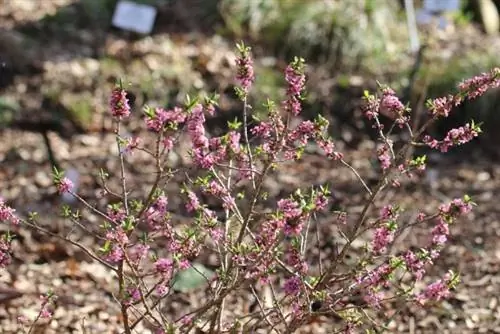
Cuttings
In order to grow an identical daphne, vegetative propagation using cuttings is particularly important. Here's how to do it:
- In June/July, cut off several offshoots with a length of 10-15 centimeters
- Remove the lower leaves and cut the upper ones in half
- Fill small pots with potting soil or inorganic substrate, such as perlite or vermiculite
- Insert one or two cuttings two thirds into each and moisten them
Rooting usually takes 6 to 8 weeks in a partially shaded, warm window seat. If the initially white roots turn brown, they can be repotted.
Lowers
The lowering method is just as easy to knit. A half-woody, one-year-old shoot is pulled to the ground. Where it touches the soil, remove the leaves and scratch it very lightly with a razor. This area is dug in a 10 centimeter deep furrow and weighted down with stones. While the mother plant supplies the sinker with nutrients, rooting takes place. Once an independent root system has formed, cut off the sinker to plant it in the new location.
Conclusion
Daphne has a captivating fascination that is based on its magnificent flowers, high site tolerance and extreme toxicity. Since the ornamental tree is not suitable for gardens with children and pets, it is not nearly as widespread as its botanical attributes suggest. This fact increases the appeal of cultivating Daphne, especially since care, cutting and propagation do not pose any significant hurdles.

